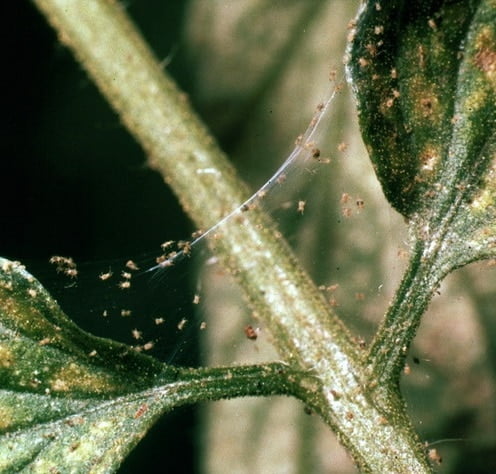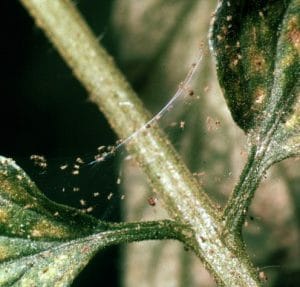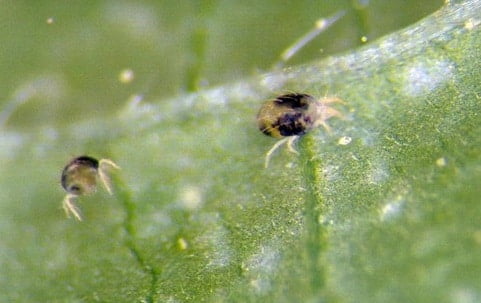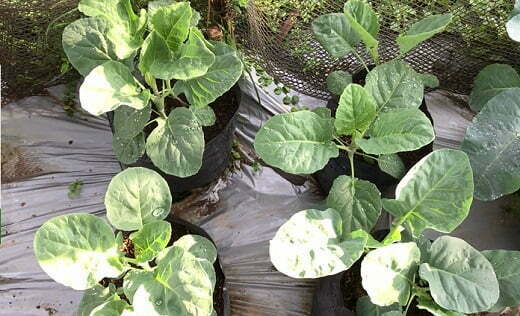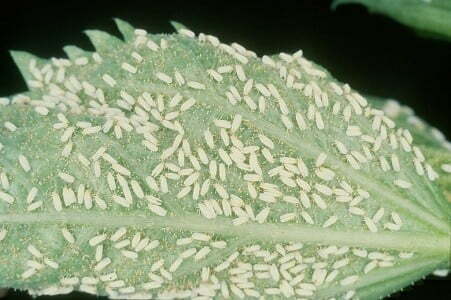How to get rid of spider mites on tomato plants? The main and alternatively, we can do 5 ways how to get rid of spider mites on tomato plants. We can see it thoroughly in this post.
According to science, there are approximately 1,200 species of spider mites around the world. These pests attack all sorts of vegetation in ways that are completely devastating, both economically and personally. And although all the species do have their differences they have one thing in common: their reproductive cycle is their strength.
Many types of spider mites
Perhaps you have heard of spider mites in relation to damaged house plants; perhaps you’ve even dealt with spider mite infestations yourself. But were you aware that there are more than one species of spider mite? There are actually about 1,200 species within the Acari family of arachnids. And as arachnids, spider mites are not insects – even though we commonly refer to them as such.
Spider mites get their name not because they resemble spiders – many don’t in fact – but because they spin beautiful and complex webs that can resemble fine silk. The big difference between the spider mite and their more well-known cousins is that the mite uses the web as a means of transportation and a medium to lay eggs in. Spiders, on the other hand, mostly use their webs to catch prey.
Tetranychus urticae
Tetranychus urticae, known more commonly as the two-spotted spider mite is the most well-known and the most prolific. It has a fierce reputation for being able to destroy large amounts of vegetation with little effort. It is also the species that most commonly invade house plants and gardens in North America. Although they can barely be seen by the naked eye, under a microscope you could definitely identify them by the two spots on either side of their bodies.
These particular spider mites love warm and dry weather because it’s optimal for both their breeding and their feeding. In terms of their breeding cycle, if temperature and humidity are just right a colony can go from a small number of spider mites to thousands in a very short period of time. In terms of their feeding, plant structures undergo certain chemical changes when they began to dry out, thereby providing a source of “super food” optimized for spider might health and breeding.
Other Species
Two more of the most well-known spider mites include Panonychus citri and Panonychus ulmi. Both will attack all sorts of vegetation though they favor fruit trees. Panonychus ulmi, in particular, is a European variety of spider mites that is dark red in color. This mite is as prolific in southwestern Europe as the two-spotted spider mite is in North America. It has an extremely quick breeding cycle which can result in thousands of offspring from a single female.
Though there are thousands of species of spider mites they all have two things in common: they reproduce very quickly and they eat voraciously. Their breeding cycle is the key to their survival especially when you consider they have so many natural predators. In other words, spider mites survive simply by sheer numbers. That’s why using chemical pesticides is not necessarily the best way to deal with them.
If you are suffering a spider mite infestation in your home or garden, we recommend you use an organic miticide like Liquid Ladybug. Liquid Ladybug will help you eradicate spider mites without harming natural predators and it will not pose a danger to your children and pets.
Spider mites have an incredibly large number of natural predators. And because they have no defense mechanisms, they are wide open for any hungry predators looking for a meal. Where natural predators are in abundance spider mite populations are kept in check. But when natural predators are killed off by pesticides and insecticides, spider mites can reproduce at an alarming rate.
Two Types of Eggs
There are two types of eggs involved in the spider mite breeding cycle. The most common are the fertilized eggs which produce female spider mites; the second type is unfertilized which produces the males. Whether by design or accident, more female eggs are produced than male eggs, helping the breeding cycle to continue. Under optimal conditions, this could mean a lot of hatchlings in a very short amount of time.
The Breeding Cycle
The breeding cycle begins when an adult female makes her home on the underside of a plant leaf. As soon as she finds a spot she begins to move across the surface of the leaf, simultaneously feeding and laying eggs as she goes. She may also spin a fine web between a leaf and the plant stem in order to lay more eggs. The female spider mite is so good at laying eggs that she can potentially put down thousands in her lifetime.
Once eggs are laid they generally take only 3 to 5 days to hatch if temperature and humidity are optimal. Under less than optimal conditions, it could be extended to 5 to 7 days. Usually, a day or so before an egg is ready to completely hatch its outer shell begins to crack as the growing hatchling requires more space. When the egg finally does completely hatch the new spider mite emerges and reaches full maturity in about seven days.
If we assume optimal temperature and humidity levels, it becomes obvious that new female spider mites are ready to begin laying eggs only 10 days after their own eggs were laid by their mother. If we assume 50% of the eggs laid are female, and the mother puts down 750 in a week, that means 375 new mothers laying eggs just 10 days later. Multiply this by the average 30-day life cycle and you have a potential nightmare.
Spider mites only survive because of their sheer numbers. But by using an organic miticide like Liquid Ladybug you can gain the upper hand by stopping the breeding cycle. Since liquid Ladybug kills adult spider mites and hatchlings alike, three applications over the course of several days should be all you need to bring an end to your spider mite infestation.
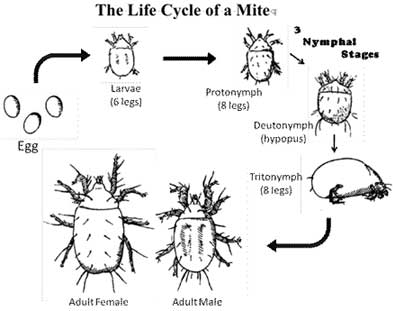
5 Methods how to get rid of spider mites on tomato plants
Spider mites are pesky little creatures that have a way of ruining greenhouses and gardens all over North America. There are over 1,000 different species of spider mites; the two-spotted species being the most common here in States. However, there is a dark reddish variation that loves fruit trees and fruiting plants. If you have tomatoes you need to be ever watchful for these red spider mites. They can decimate a tomato crop in a very short amount of time.
Because tomato plants can grow extremely large and heavy, treating them requires you to be thorough and patient. That means whether you use water, household products, organic miticides, or chemical pesticides, you need to make sure you take the time to do it right. If you miss just one small portion of an infested plant you are leaving the door wide open for eggs to hatch and the breeding process to begin all over again.
Watering
The experts say you should always start with watering on the first signs of infestation. Spider mites and water don’t get along all that well. Sometimes, if an infestation is minor, watering can be enough to eradicate it. More often than not this won’t be the case for moderate to large tomato plants. In such a case you will almost always have to use some sort of substance to kill existing mites and eggs.
Killing Spider Mites
Many home gardeners suggest things like neem oil, tobacco juice, soapy water, and even coffee. These home remedies have been known to work from time to time due to the fact that spider mites are very sensitive to their environments. However, whether these substances actually kill the mites or just drive them away is a matter of debate. If you want to make sure they are completely eradicated you should look for a commercial product designed specifically to both kill adults and deal with the eggs.
For tomatoes, a good product is Liquid Ladybug. We can assure you that it is completely safe because it is an organic substance made from the essential oils of certain plants. To use liquid ladybug you simply spray your plants in their entirety; this will kill all the adults and penetrate any eggs that have already begun to crack. Then you do two more treatments over the course of three days to ensure that all of the eggs are eventually dealt with as they go through their maturation process. If you follow the instructions you should completely eradicate spider mites from your tomatoes within 3 to 5 days.
After that, you can work to prevent future infestations by using a combination of watering and periodic applications of Liquid Ladybug. During the peak season, you may need to apply liquid Ladybug every 21 to 30 days. Outside of the peak season an application every couple of months will probably be sufficient. Just follow the instructions on the packaging and you shouldn’t have any further problems with spider mites.
Anyone who’s ever had experience with spider mites knows that failing to control them could mean disaster for houseplants and gardens. Because these insects breed so prolifically it’s important to get a handle on an infestation in its early stages before populations explode. There are several ways to do this including natural methods, organic miticide, and chemical pesticides. Which method is right for you depends upon the seriousness of your infestation and your personal comfort level with chemicals.
Natural Methods
The first spider mite treatment option is to use natural methods that incorporate water and natural predators. The water portion of the treatment involves liberal watering of plant stems and leaves upon the earliest signs of infestation and then continued watering until the infestation is eliminated. Watering is important because it keeps mites off your plants. However, it does not kill the mites, which is where the second portion of the treatment comes in.
Ladybugs are one of the spider mites’ natural predators. You can purchase ladybugs from suppliers who specialize in natural pest control. By releasing ladybugs into the environment you will be able to get rid of most of your spider mites without causing any harm to children, pets, etc. If your infestation is completely indoors, and releasing ladybugs or other predators is not attractive to you, the second treatment option is probably better.
Organic Miticides
The second option is to use an organic miticide like Liquid Ladybug. This kind of product uses a formula made from the essential oils of certain plants. These oils are deadly to spider mites but are harmless to predators, as well as human beings and our pets.
When applied to plants that are infested the organic miticide kills adult mites on contact by penetrating the outer shell and disintegrating their inner parts. These essential oils are also able to seep into small cracks in spider mite eggs and kill hatchlings in the same way. By using something like Liquid Ladybug over the course of three days, you can completely eliminate most spider mite infestations.
Chemical Pesticides
Chemical pesticides are often used by farmers and those with extremely large gardens in order to control very sizable infestations. While this is certainly possible, it should be reserved only for large-scale operations. Chemical pesticides not only kill spider mites, they also kill the mite’s natural predators, which only help future colonies reproduce more successfully. Chemical pesticides also pose a potential danger to your children, your pets, and groundwater.
Once a spider might infestation has been eliminated you can best prevent future infestations with a combination of natural methods and organic miticide. If you continue to inspect leaves daily, spray them with water, and use your organic miticide according to the directions, you should be able to stave off future problems.
This is how to get rid of spider mites on tomato plants, hopefully, this useful.
 JOYNIM FARM Goat Farming, Cattle Farm, Laying Hens, Quail Farm, Gardening
JOYNIM FARM Goat Farming, Cattle Farm, Laying Hens, Quail Farm, Gardening
